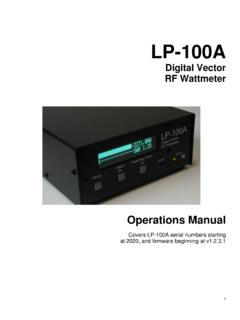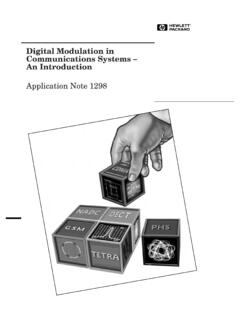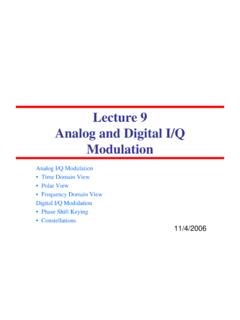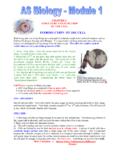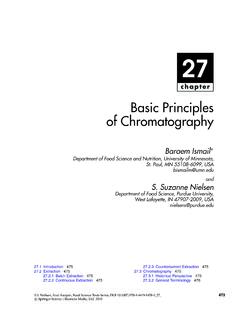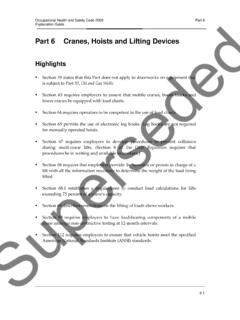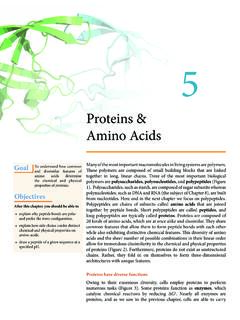Transcription of Presentation ID 1
1 111 2001, Cisco Systems, Inc. All rights 2001, Cisco Systems, Inc. All rights NumberPresentation_IDQPSK and 16-QAM Digital ModulationRon Hranac333 2001, Cisco Systems, Inc. All rights information such as sound (audio), images (video), and digital data can be transmitted from one point to another using radio waves This is done by modulating an RF signal a carrier with the information to be transmitted Modulationis the variation one or more properties of an RF signal to represent the information being transmitted444 2001, Cisco Systems, Inc.
2 All rights One or more of the following properties of an RF signal may be varied to convey information :Amplitude Amplitude of a carrier is varied. This is called amplitude modulation (AM).Frequency Frequency of a carrier is varied. This is called frequency modulation (FM).Phase Phase of a carrier is varied. This is called phase modulation (PM).555 2001, Cisco Systems, Inc. All rights AM: amplitude modulationFM: frequency modulationPM: phase modulationHere are three examples of commonly used modulation techniques, showing modulated signals in the time domain.
3 In these examples the horizontal axis is time, and the vertical axis is 2001, Cisco Systems, Inc. All rights A radio receiver TV set, AM or FM radio, and even a cable modem or CMTS detects an RF signal s variations, and creates a nearly identical copy of the original modulating signal from those 2001, Cisco Systems, Inc. All rights Digital Modulation Formats FSK Frequency shift keying: information is transmitted by shifting between two frequencies to represent zeroes and ones10888 2001, Cisco Systems, Inc. All rights Digital Modulation Formats ASK Amplitude shift keying: The amplitude of a carrier is shifted between two states to represent zeroes and ones10999 2001, Cisco Systems, Inc.
4 All rights Digital Modulation Formats PSK Phase shift keying: The phase of a carrier is varied between two states to represent zeroes and onesIf the phase shift between the two states is 180 degrees, the modulation is called BPSK, or biphaseshift keying10101010 2001, Cisco Systems, Inc. All rights About carrier Phase These graphics represent RF carriers in the time domain with different phases relative to one another. They all have the same frequency and the same amplitude. Assume that the top carrier is assigned an arbitrary phase value of 0 The second carrier s phase relative to the first one is delayed 45 , the third carrier is delayed 90 , the fourth carrier 135 and so on 0 45 90 135 180 225 270 315 111111 2001, Cisco Systems, Inc.
5 All rights Modulation Amplitude andphase can be modulated simultaneously and separately to convey more information than either method alone, but is difficult to do An easier way is to separate the original signal into a set of independent components or channels: I(In-phase) and Q(Quadrature) The Iand Qcomponents are considered orthogonalor in quadraturebecause they are separated by 90 degrees The Iand Qcomponents are summed in a modulator circuit121212 2001, Cisco Systems, Inc. All rights ModulationPolar display Magnitude and phase represented together I-Q format Polar to rectangular conversion131313 2001, Cisco Systems, Inc.
6 All rights Modulator90 phase shiftQI A single carrier generated by a local oscillator ( ) circuitis split into two paths One path is delayed by an amount of time equal to of the carrier s cycle time, or 90 degrees The two carriers are amplitude modulated one by the Isignal, the other by the Qsignal The two modulated carriers are added together in a summing circuit The output is a digitally modulated signal whose amplitude and phase are determined by the amplitudes of the two modulating signals141414 2001, Cisco Systems, Inc. All rights QPSK: quadrature phase shift keying Quadraturemeans the signal shifts among phase states that are separated by 90 degrees The signal shifts in increments of 90 degrees from 45 to 135 , -45 (315 ), or -135 (225 ) Data into the modulator is separated into two channels called Iand Q Two bits are transmitted simultaneously, one per channel151515 2001, Cisco Systems, Inc.
7 All rights Each channel modulates a carrierThe two carrier frequencies are the same, but their phase is offset by 90 degrees (that is, they are in quadrature ) The two carriers are combined and transmitted Four states because 22= 4 Theoretical bandwidth efficiency is two bits/second/Hz161616 2001, Cisco Systems, Inc. All rights Symbol Mapping171717 2001, Cisco Systems, Inc. All rights ConstellationSymbol TransmittedCarrier PhaseCarrier Amplitude00225 0 90 135 180 225 270 315 181818 2001, Cisco Systems, Inc. All rights ConstellationIQSymbol TransmittedCarrier PhaseCarrier Amplitude00225 2001, Cisco Systems, Inc.
8 All rights ConstellationIQSymbol TransmittedCarrier PhaseCarrier Amplitude00225 2001, Cisco Systems, Inc. All rights ConstellationIQSymbol TransmittedCarrier PhaseCarrier Amplitude00225 2001, Cisco Systems, Inc. All rights ConstellationIQSymbol TransmittedCarrier PhaseCarrier Amplitude00225 2001, Cisco Systems, Inc. All rights 16-QAM: 16-state quadrature amplitude modulation Four Ivalues and four Qvalues are used, yielding four bits per symbol 16 states because 24= 16 Theoretical bandwidth efficiency is four bits/second/Hz232323 2001, Cisco Systems, Inc.
9 All rights Data is spit into two channels, Iand Q As with QPSK, each channel can take on two phases. However, 16-QAM also accommodates two intermediate amplitude values! Two bits are routed to each channel simultaneously The two bits to each channel are added, then applied to the respective channel s modulator242424 2001, Cisco Systems, Inc. All rights ConstellationIQSymbol TransmittedCarrier PhaseCarrier Amplitude0000225 90 180 270 45 315 225 135 252525 2001, Cisco Systems, Inc. All rights ConstellationIQSymbol TransmittedCarrier PhaseCarrier Amplitude0000225 2001, Cisco Systems, Inc.
10 All rights ConstellationIQSymbol TransmittedCarrier PhaseCarrier Amplitude0000225 2001, Cisco Systems, Inc. All rights ConstellationIQSymbol TransmittedCarrier PhaseCarrier Amplitude0000225 2001, Cisco Systems, Inc. All rights ConstellationIQSymbol TransmittedCarrier PhaseCarrier Amplitude0000225 2001, Cisco Systems, Inc. All rights ConstellationIQSymbol TransmittedCarrier PhaseCarrier Amplitude0000225 2001, Cisco Systems, Inc.
